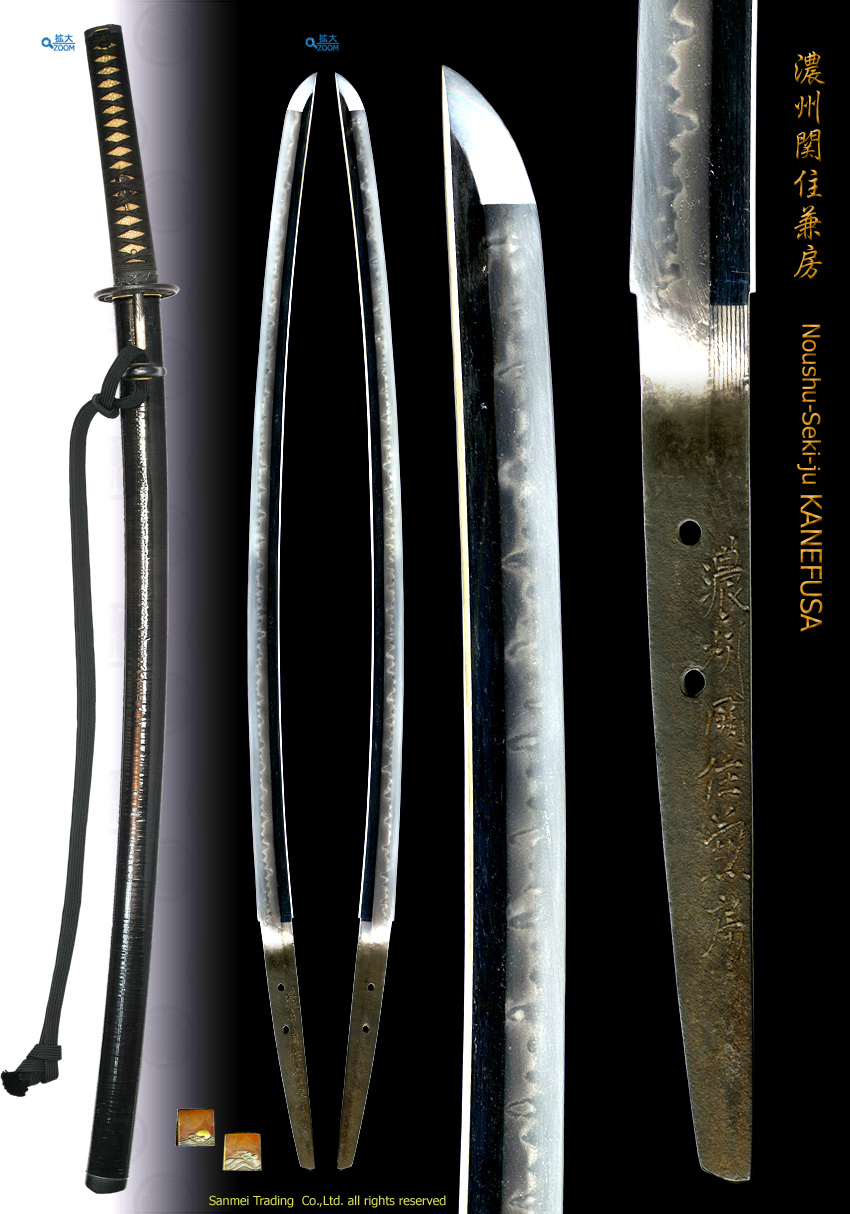with) Black Roiro lacquered Sendan-style Shower-notches scabbard Uchikatana Koshirae
Length of cutting edge 72.2cm Curvature 1.9cm Width of base 30.1mm Width of Yokote 20.9mm Thickness of base 7.6mm
Kitae(forging pattern) : Kitae is fine Itame (weaved wooden grain). Sparking Ji-nie is lying over the entire surface.
Hamon(tempering pattern) : Hamon is Ko-nie a bit on tighter side, passage of triple-Gunome so called Sanbon-sugi The interior is filled with misty sparkling Nioi where some bright Niju-ha appears and long Nie-lines of Sunagashi streams. Thick Ashi feet radiates toward the cutting edge. Upper Monouchi area activates with isolated Muneyaki along the back ridge. The entire quench scene shows abundant activity of fine Nie as well as misty Nioi.
Boshi (tip): Temper of Boshi is widely irregular in Madarekomi state and turns deeply back that connects to Mueyaki.
Nakago(tang) : The Nakago is UBU whereas cutting edge is slightly shortened Machi-okuri on about 1-sun (3cm). Two Mekugi-ana retaining holes. Ō-sujikai greatly slanting left file marks. The bottom heel is Iriyama Single-bevelled. Back ridge of Nakago is flat with Ō-sujikai filemarks also. The signature is located on Shinogi-ji in front, chiselled in strong, large that starts from the place of work Noushu-Seki-ju 濃州関住 and then a name of smith KANEFUSA 兼房.
During the medieval Muromachi period, several generations of sword masters named KANEFUSA 兼房 who lived in Seki town had been one of the the most famous also played major role of sword production to meet with increasing demand from powerful Samurai. His workmanship was wide in the idiom such as " KenboMidare" (slender waist, round head clove shape) also "Sanbon-sugi" (triple aligned Sharpened head) like this example or "Suguha" that originated in Yamashiro tradition .
From the encyclopedia [Nihonto Meikan], the founder KANEFUSA 兼房 was active in Eikyo era (1429-) as a son of KANESHIGE 兼重 but the earliest specific date of year is Bunmei 1 (1469) who is judged as a practical 1 st generation. KANEFUSA with date of year Bunmei 12 (1480) and 14 (1482) is provisional 2 nd generation and KANEFUSA with Iwami-no-kami 石見守 title of Daiei 7 (1527) is supposed to be 3 rd gen.
The later generations in Koto period in Eiroku-Genki era (1558-72) as the 4 th KANEFUSA and the 5 th KANEFUSA would be active during Genki-Tensho era (1558-91). Those KANEFUSAs of end Muromachi period are very good at quenching pattern of Kenbo Midare and had a great influences on the other sword makers in Seki town.
Noble sword smith Wakasa-no-kami UJIFUSA 若狭守氏房 was born in the 3 rd year of Tenbun (1534) as the 3 rd son of the 3 rd gen. Iwami-no-kami KANEFUSA 石見守兼房 in Gifu. He won the praise from the daimyo Oda Nobunaga and exclusively belonged to him.
The subject stirring Uchi-katana is a sublime work by the 5th generation KANEFUSA 兼房. Heroically wide in Mihaba as well as upper area of Fukura is swelling out leading to a powerful Kissaki. For the history passage of 450 years more, it holds magnificent shape and glows rich quenching activities of Nie and Nioi. He enjoyed a high reputation as Yoki-Wazamono "Supreme Sharp" cutting performance.
with) Black Roiro lacquered Sendan-style Shower-notches scabbard Uchikatana Koshirae consists of : (click HERE for entire Koshirae and HERE for each fitting)
- Fuchi/Kashira : Reed and wild goose design. Shakudo Nanako-ji surface, Takabori carving, Gold Ioe, singed as Yanagawa NAOMASA 柳川直政
- Menuki : Hotei god of good luck, Shakudo ground, Yobori carving, Gold Iroe
- Tsuba : Iron ground, bell-ringing Cricket design, Both Hitsuana unsigned Akasaka
- Tsuka : White rayskin with large dimples, Brown silk cord lozenge wrap
- Wari-Kougai : Silver polish surface, Shakudo Iroe Samidare-rain shower design unsigned
- Single layer wave-design decorative Habaki
Preserved in Shirasaya plain wood mounting
Recent polish/Condition scale: very good (using a scale of mint-excellent-very good-good-fair-poor)
reference data :
Suzuki Takuo/Sugiura Yoshiyuki, Muromachi-ki Mino-Toko-no-kenkyu, Ribun shuppan , 2006



